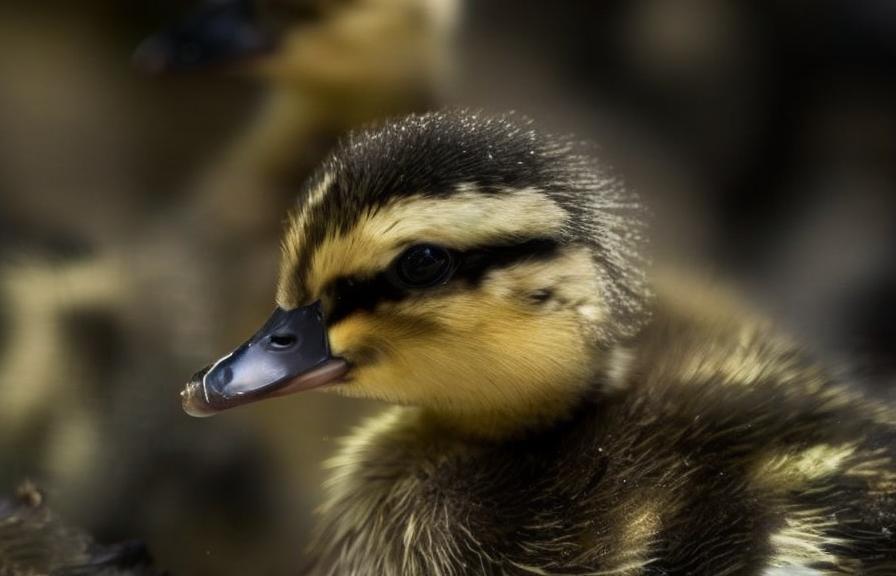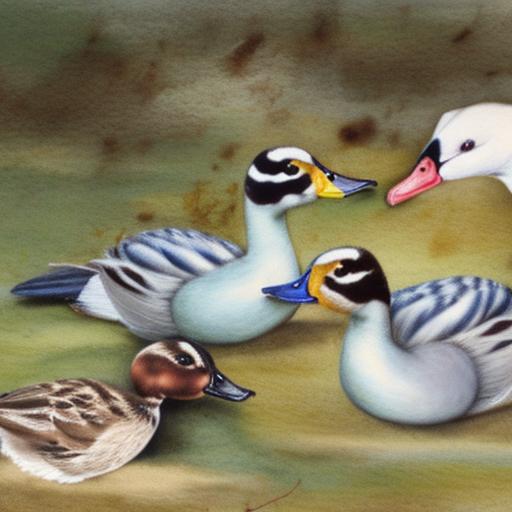Ducklings are adorable and fluffy little creatures that are a joy to raise and care for. They are the young offspring of ducks and are known for their cute appearance and playful nature. Ducklings are often raised as pets, for their eggs, or for their meat. They are social animals that thrive in the company of other ducklings and enjoy swimming and foraging for food. Ducklings are also known for their gentle and friendly demeanor, making them a popular choice for families looking to add a unique and charming pet to their household.
Ducklings are also known for their adaptability and resilience, making them relatively easy to care for. They can be raised in a variety of environments, including backyard ponds, farms, and even urban settings. Ducklings are also known for their ability to form strong bonds with their human caretakers, making them a beloved addition to any family. In this article, we will explore the popular breeds of ducklings, their behavior and care, physical characteristics, development and growth, differences between breeds, and how to choose the right breed of duckling for your specific needs and preferences.
Key Takeaways
- Ducklings are young ducks that require special care and attention during their early stages of life.
- Popular breeds of ducklings include Pekin, Mallard, Khaki Campbell, and Runner ducks, each with their own unique characteristics and traits.
- Ducklings are social animals that require companionship and a safe environment to thrive.
- Ducklings have soft down feathers, webbed feet, and a distinctive bill that sets them apart from other poultry.
- Understanding the differences between duckling breeds is important when choosing the right breed for your specific needs and environment.
Popular Breeds of Ducklings
There are numerous breeds of ducklings, each with its own unique characteristics and traits. Some of the most popular breeds include the Pekin, Mallard, Khaki Campbell, Rouen, and Muscovy. The Pekin duckling is known for its white feathers and orange bill, and is one of the most common breeds raised for meat production. They are also popular as pets due to their friendly nature and easygoing temperament. The Mallard duckling is the most common wild duck species in North America and is known for its beautiful iridescent green head and vibrant plumage. They are often raised for their eggs and as pets due to their striking appearance.
The Khaki Campbell duckling is a popular breed known for its excellent egg-laying abilities, with some individuals laying up to 300 eggs per year. They are also known for their calm and friendly demeanor, making them a popular choice for backyard flocks. The Rouen duckling is a large breed with stunning plumage that resembles the Mallard. They are often raised for meat production and as pets due to their gentle nature. The Muscovy duckling is a unique breed known for its distinctive red facial caruncles and quiet nature. They are often raised for meat production and as pets due to their calm temperament and excellent foraging abilities.
Behavior and Care of Ducklings
Ducklings are social animals that thrive in the company of other ducklings or adult ducks. They are also known for their playful and curious nature, often engaging in activities such as swimming, foraging for food, and exploring their surroundings. Ducklings require access to water for swimming and bathing, as well as a balanced diet that includes commercial duck feed, fresh vegetables, and access to insects and other natural foods. They also require a safe and secure shelter to protect them from predators and the elements.
Ducklings also require regular veterinary care to ensure they remain healthy and free from diseases. It is important to provide them with a clean and comfortable living environment, regular access to fresh water, and plenty of opportunities for exercise and mental stimulation. Ducklings also benefit from social interaction with their human caretakers, as well as other ducks, to ensure they remain happy and well-adjusted. Overall, ducklings are relatively easy to care for but require attention to detail and a commitment to meeting their specific needs.
Physical Characteristics of Ducklings
Ducklings are known for their adorable appearance, with fluffy down feathers, webbed feet, and a distinctive bill. They come in a variety of colors and patterns, depending on the breed, with some featuring striking plumage and vibrant markings. Ducklings have a round body shape with short legs and a waddling gait that adds to their charm. Their down feathers provide insulation and protection from the elements, while their webbed feet are designed for swimming and foraging in water.
Ducklings also have a unique bill that is adapted for feeding on a variety of foods, including insects, plants, and small fish. Their bills are also used for preening their feathers and communicating with other ducks through vocalizations. Overall, ducklings are well-adapted to their natural environment and have physical characteristics that make them well-suited for a variety of purposes, including as pets, egg layers, or meat production.
Duckling Development and Growth
Ducklings undergo rapid development and growth during their first few weeks of life. They hatch from eggs after an incubation period of around 28 days, depending on the breed. Once hatched, ducklings are covered in down feathers that provide insulation and protection from the cold. They are also able to walk, swim, and feed themselves shortly after hatching, although they still require warmth and protection from predators.
As they grow, ducklings begin to develop adult feathers and lose their down feathers, undergoing a process known as molting. This process can take several weeks to complete, during which time ducklings may appear scruffy or unkempt. As they mature, ducklings also begin to exhibit sexual dimorphism, with males developing more vibrant plumage and distinctive markings compared to females. Overall, the development and growth of ducklings is a fascinating process that highlights their adaptability and resilience as young waterfowl.
Differences Between Duckling Breeds

Each breed of duckling has its own unique characteristics and traits that set it apart from others. These differences can include size, coloration, temperament, egg-laying abilities, foraging behavior, and overall suitability for specific purposes such as meat production or pet ownership. For example, Pekin ducklings are known for their large size and excellent meat production capabilities, while Khaki Campbell ducklings are prized for their prolific egg-laying abilities.
Mallard ducklings are known for their striking appearance and adaptability to various environments, making them a popular choice for backyard ponds or urban settings. Muscovy ducklings are unique in their appearance and quiet nature, making them an interesting addition to any flock. Understanding the differences between duckling breeds is important when choosing the right breed for your specific needs and preferences.
Choosing the Right Breed of Duckling
When choosing the right breed of duckling, it is important to consider your specific goals and preferences. If you are looking for a breed that is well-suited for meat production, then Pekin or Rouen ducklings may be the best choice due to their large size and excellent meat quality. If you are interested in raising ducks for eggs, then Khaki Campbell or Mallard ducklings may be the best choice due to their prolific egg-laying abilities.
For those looking for a unique and charming pet, Muscovy or Mallard ducklings may be the best choice due to their striking appearance and calm temperament. It is also important to consider the space available for raising ducklings, as some breeds may require more room to roam compared to others. Overall, choosing the right breed of duckling requires careful consideration of your specific goals, available resources, and commitment to meeting the needs of these delightful waterfowl.
In conclusion, ducklings are delightful creatures that bring joy and charm to any household or farm. Their playful nature, unique physical characteristics, rapid development and growth, as well as differences between breeds make them an interesting subject of study for animal enthusiasts. Understanding the behavior and care of ducklings is essential when considering raising them as pets or for specific purposes such as egg-laying or meat production. By choosing the right breed of duckling based on your specific needs and preferences, you can enjoy the companionship of these adorable waterfowl while contributing to their well-being and happiness.
If you’re considering raising ducklings, it’s important to understand the different breeds of ducks as babies and how to care for them. Whether you’re planning to turn a shed into a duck coop or looking for ideas for a large duck coop, it’s essential to provide a safe and comfortable environment for your ducklings to thrive. For helpful tips on creating the perfect duck coop, check out this informative article on turning a shed into a chicken coop.
FAQs
What are the different breeds of ducks as babies?
Some common breeds of ducks as babies include Pekin, Mallard, Rouen, Khaki Campbell, and Muscovy.
How can you identify the breed of a duck as a baby?
The breed of a duck as a baby can often be identified by its physical characteristics such as color, size, and markings. However, some breeds may look similar as babies and may require expert knowledge to differentiate.
Do different breeds of ducks as babies have different care requirements?
Yes, different breeds of ducks as babies may have slightly different care requirements such as temperature, diet, and space. It’s important to research the specific needs of the breed you have.
At what age do baby ducks start to show their breed-specific characteristics?
Baby ducks may start to show their breed-specific characteristics as early as a few weeks old, but some characteristics may not fully develop until they are older.
Are there any specific health concerns or considerations for different breeds of ducks as babies?
Yes, some breeds of ducks as babies may be more prone to certain health issues or require specific care to prevent common problems. It’s important to be aware of any breed-specific health concerns and consult with a veterinarian if needed.
Meet Walter, the feathered-friend fanatic of Florida! Nestled in the sunshine state, Walter struts through life with his feathered companions, clucking his way to happiness. With a coop that’s fancier than a five-star hotel, he’s the Don Juan of the chicken world. When he’s not teaching his hens to do the cha-cha, you’ll find him in a heated debate with his prized rooster, Sir Clucks-a-Lot. Walter’s poultry passion is no yolk; he’s the sunny-side-up guy you never knew you needed in your flock of friends!







